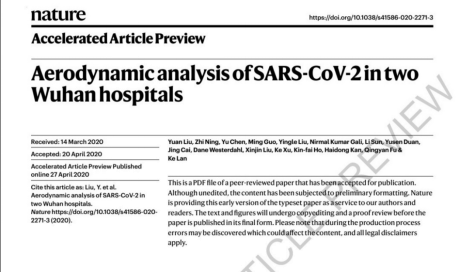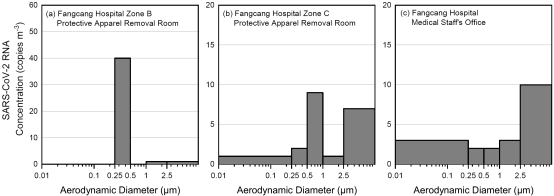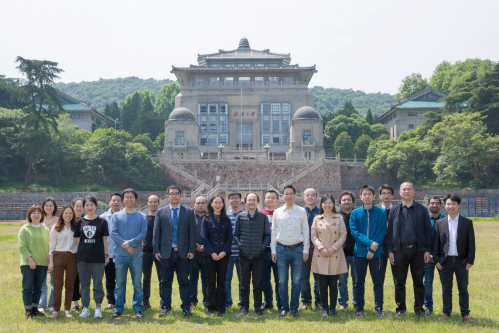On April 27, Nature published the latest research findings of the anti-epidemic technology research team led by Prof. Lan Ke, head of the State Key Laboratory of Virology of Wuhan University. The paper is entitled Aerodynamic Analysis of SARS-CoV-2 in two Wuhan Hospitals and is recommended as a Featured article by Nature.

Wuhan University is the first author affiliation. Professor Lan Ke, Senior Engineer Fu Qingyan (Professor Level) of Shanghai Environmental Monitoring Center, Professor Kan Haidong of Fudan University, and Professor He Jianhui of the Chinese University of Hong Kong are co-corresponding authors of the paper. Liu Yuan, Chen Yu, and Guo Ming from the State Key Laboratory of Science and Ning Zhi of the Hong Kong University of Science and Technology are co-first authors. The research is sponsored by the Wuhan University New Coronary Pneumonia Research Special Fund, Taikang Group and Beijing Taikang Yicai Charity Foundation, as well as the East Branch of Renmin Hospital of Wuhan University and Wuchang Mobile Cabin Hospital.
The outbreak of COVID-2019 around the world poses a huge threat to public health. Cutting off the transmission of the virus is one of the key measures to prevent the virus from spreading. It proves that droplet and contact are the main routes of transmission of 2019-nCoV, while little is known about the aerosol transmission. In the prevention and control of COVID-19, medical staff on the frontlines are often exposed to a large number of aerosols produced by patients during clinical treatment operations, such as sputum suction and intubation; and because of lack of knowledge of aerosol science, many people become anxious and dazed as they regard it as “an unpreventable airborne transmission”.
The State Key Laboratory of Virology of Wuhan University responded to public concerns and provided a reference for the government’s epidemic prevention and control decisions. During the peak of the epidemic in Wuhan, Prof. Lan Ke led the team to the intensive and general wards of the East Branch of Renmin Hospital of Wuhan University, wards and toilets of Wuchang Mobile Cabin Hospital, residential quarters and supermarkets and some other hospitals and public places to collect aerosol samples. Also, they quantitatively analyze the aerosol load and aerodynamic characteristics of the 2019-nCoV samples at each sampling point through digital PCR detection technology developed by the team earlier.
The research findings showed that the strict prevention and control at the time have basically guaranteed the safety of the two hospitals and the public places. However, the aerosol virus load is higher in the toilets used by patients, indicating that flushing might be an important source of viral aerosols; a certain amount of aerosol virus can be detected near supermarkets where crowds flow and on hospital building passageways, suggesting that there is a potential risk of aerosol transmission when the virus carrier and surrounding people gather. In addition, the team proved that the aerodynamic characteristics of 2019-nCoV aerosol for the first time by analyzing the virus aerosol load and particle size distribution in the ward dust samples and the area where medical staff took off protective clothing, and proposed the virus aerosol propagation mode of "Settling —Carrying—Spreading ”.
After analyzing and summarizing the above-mentioned first-hand environmental aerosol virus load data during the peak of epidemic in Wuhan, the team delivered a research report on February 28, 2020 and submitted it to the Science and Technology Research Group of the Hubei Provincial Epidemic Prevention and Control Headquarter and related hospitals, which then became part of the government's decision-making reference and the scientific basis for hospitals to formulate prevention and control strategies. The research results were also published online on the main international preprint website bioRxiv on March 10, 2020. As a research reporting the aerosol load and aerodynamic results of 2019-nCoV monitored in the real environment, the preprint of the paper has been read and downloaded more than 50,000 times over the past month, attracting attentions from more than 140 academic journals and science websites at home and abroad, such as Nature, Science and well-known websites, The Scientist and Cosmos, as well as the mainstream media such as NPR, Yahoo, CCTV and China News. Among them, reporter of Nature and editor-in-chief of Cosmos interviewed Lan Ke on the experimental design and scientific significance of aerosol virus load research, and respectively reported it as headlines news on the website on April 2 and 7, 2020.
After the outbreak of the epidemic in the US, the American Academy of Sciences, the Academy of Engineering and the Medical College jointly quoted the research results in the entire paragraph of the emergency consultation report submitted to their president on April 1, 2020. Soon after, the President of the United States began calling on people to implement personal protective measures such as wearing masks. In short, this study not only proved the environmental aerosol virus load and dynamic characteristics for the first time, but also gave a reference for epidemic prevention and control, which is of great scientific value and social significance.
It is reported that under full supports from Wuhan University, the State Key Laboratory of Virology immediately established an anti-epidemic technology research team led by the head of laboratory Prof. Lan Ke after the outbreak, which is also one of the teams that identified the 2019-nCov and has made important contributions to the instant targeting of pathogens in the early stages of the outbreak in China. The two 2019-nCov genome sequences identified by the team (WHU01, WHU02) were cited as important reference sequences in the China-World Health Organization COVID-19 Joint Investigation Report released in February, 2020.
Since launching the research, the team has made a series of important achievements in the discovery and identification of novel coronavirus, innovative detection technology, drug research and development, environmental aerosol virus load monitoring, pathogenic mechanism, and research on emergency in clinical hospitals. Moreover, the team has published several papers in important academic journals such as Nature, New England Journal of Medicine, The Lancet, New Microorganisms and Infections, Clinical Infectious Diseases, etc., offering technological support to the prevention of Covid-19. The accomplishment of the team have also been reported by Xinhua News Agency, China News Service, Guangming Daily, Central Radio and Television Station, People's Network, CCTV and other media.

2019-nCoV load at each sampling point in hospital and public place
(Copy Number / Cubic Meter of Air)

The particle size of 2019-nCoV

Prof. Lan Ke and his team
Introduction to Professor Lan Ke

Lan Ke, winner of the National Distinguished Young Science Foundation and leading expert in the 10,000-person plan.
Graduated from the Department of Clinical Medicine of Chongqing Medical University (1994).
Graduated from Xiangya Medical College of Central South University (2001).
Conducted postdoctoral research in the Department of Microbiology, University of Pennsylvania School of Medicine (2002-2006).
Researcher of the Pasteur Institute (PI) (2006-2016).
Served as the deputy director and secretary of the Disciplinary Committee of the Institute, from (2011-2016).
Director of the State Key Laboratory of Virology, Wuhan University, Deputy Dean of the Medical Research Institute, Professor of the School of Life Sciences, Doctoral Supervisor (2017-).
Main Research Area: viral infection and pathogenic mechanism, research and development of antiviral drugs, etc.,
Published over 100 papers in Nature, New England Journal of Medicine, Science Advances, Cell Host Microbe, PNAS, Hepatology, PLoS Pathogens, Journal of Virology, Cancer Research, Cell Research, Antiviral Research and other important academic journals.
Academic part-time jobs : editorial board member of Journal of Virology and Viruses; deputy editor-in-chief of Virologica Sinica, Journal of Medical Virology, Science Bulletin, committee member of Viral Professional Committee of Chinese Society of Microbiology, deputy chairman of the Tumor Virus Special Committee of the Chinese Research Hospital Association, vice chairman of the Hubei Society of Microbiology, etc.
Rewritten by: Zhao Mengchen
Edited by: Cao Siyi, Shen Yuxi and Hu Sijia